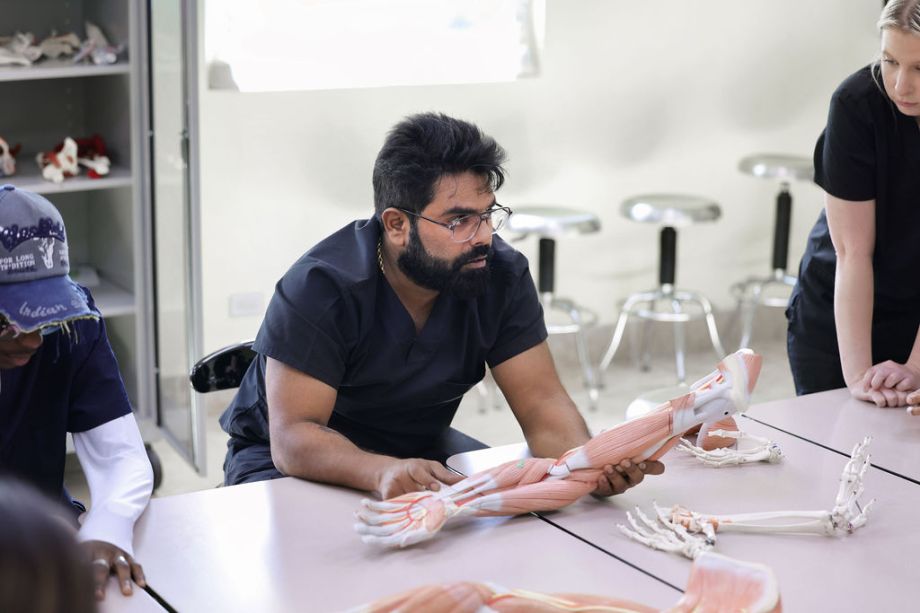
DO vs. MD Degree: What’s the Difference?
Explore the similarities and differences between these two practicing medical doctor degrees.
If you aspire to pursue a career in medicine, you have likely come across Doctor of Osteopathic Medicine (DO) and Doctor of Medicine (MD) degrees.
The difference between DO and MD may be subtle in practice, but it is essential to understand the similarities and differences between these two medical degrees before selecting a program.
So, DO degree vs. MD. Let’s explore the ins and outs of both medical degrees to discover which pathway is right for you.
What are MD and DO Degrees?
MDs and DOs are both medical professionals who are eligible to be licensed to prescribe medication and practice medicine throughout the U.S. and Canada. While MD and DO degrees offer similar programs, an MD is a Doctor of Medicine and a DO is a Doctor of Osteopathic Medicine.
What is a DO degree? DO degrees are built on the philosophy of osteopathy, focusing on treating the body as a whole rather than treating specific conditions. DO and MD degrees teach students similar procedures and evaluation methods to diagnose, treat and prevent diseases and injuries. However, a core part of DO degrees is osteopathic manual medicine (OMM), also known as osteopathic manipulative treatment (OMT), which requires an extra 200 hours of coursework.
What is an MD degree? While DO degrees focus on osteopathy, an MD degree focuses on the traditional allopathic medicine approach to treat infection, illness and disease. Most medical schools teach allopathic medicine, emphasizing the effectiveness of using research-based medications and techniques like X-rays and surgery to identify and treat illnesses.
Similarities Between MDs and DOs in Practice
Having followed similar educational routes and received similar training during medical school, the similarities between the day-to-day operations of MDs and DOs are not surprising. Despite the difference between allopathic vs. osteopathic approaches, MDs and DOs require rigorous study, residency programs and licensing exams to practice medicine. MD and DO degrees also utilize the latest medical knowledge to deliver the best care and treatments.
In addition to similarities in training and education, MDs and DOs can pursue the same specialties, including surgery, cardiology and pediatrics. This means MDs and DOs often work side-by-side during practice.
Despite DOs being the ones who primarily rely on the osteopathic approach to medicine, emphasizing a holistic approach to preventing illnesses, MD training also stresses the importance of preventative measures while addressing medical conditions. Similarly, DOs consider a scientific approach and the advantages of evidence-based medicine, like in an MD program.
The similarities between DO and MD educations mean that sometimes the only indication to a patient may be the letters after a doctor’s name!
Key Differences in MD and DO Practice Styles
As mentioned, the key difference between DO and MD practice styles is the allopathic vs. osteopathic approaches to treatment. Through OMT training, DOs gain an in-depth understanding of how bones, muscles and nerves combine and their effects on overall health. This influences their approach to treatment, offering alternative, hands-on methods to diagnose and treat illnesses and injuries, when compared to allopathic medicine. However, it is important to note that not all DOs use OMT during practice.
MDs practice an allopathic approach to care, focusing on contemporary, research-based medicine to treat and manage various conditions. This is seen as the scientific approach to diagnosing and treating medical conditions, while osteopathy adopts a holistic, mind-body-spirit approach, focusing on preventative care.
The differences in practice styles between MDs and DOs can lead to different approaches to chronic and acute medical conditions. MDs are likely to focus on specific treatments for a targeted area of the body, while DOs may be more inclined to take a holistic approach, considering the whole body and utilizing OMT training.
Education and Training Paths for DO and MD
The education routes are very similar for DOs and MDs. They often earn a four-year undergraduate degree (or undertake a relevant pre-medical program) before enrolling in a four-year MD or DO degree program at a medical school or a college of osteopathic medicine. Following this, MDs and DOs must complete 3-7 years of residency training (depending on their chosen specialty), which can be followed by a fellowship.
Therefore, MDs and DOs receive similar medical training, and both must pass licensing exams to practice medicine. MDs take the United States Medical Licensing Examination (USMLE), while DOs take the Comprehensive Medical Licensing Examination (COMLEX). Some DOs may also sit the USMLE for various reasons, including improving their application for competitive residency programs.
The key difference between DO and MD training is that DOs complete an additional 200 hours of coursework during the four-year DO degree. The training focuses on the relationship between bones, muscles and nerves, and trains DOs in OMT methods.
DO vs MD Degree: How to Choose
Medical students must consider various factors when deciding between a DO and MD degree, with both degrees offering a path to becoming a licensed medical doctor.
Here are some factors that can help students determine which route aligns with their personal and professional goals:
1. Popularity and recognition
There is a significant disparity between the number of MDs and DOs, with a 2020 census of licensed physicians by the Federation of State Medical Boards (FSMB) finding that over 90% of doctors in the U.S. have an MD degree. This shows the popularity of MD programs and leads to wider recognition for MDs, which can affect international career opportunities.
Despite this, in 2021, the American Osteopathic Association (AOA) reported an 81% increase in the total number of DOs and osteopathic medical students over the past decade, highlighting increased popularity among medical students.
2. Location
It is important to consider location when weighing up DO vs. MD degrees, as some areas have more MDs while others have more DOs. This is a key consideration when applying for residency, with some residencies and locations more suitable and less competitive for MDs or DOs.
3. Licensing exams
MD and DO students must pass all three stages of their respective licensing exams. MD students take the USMLE, while DO students take the COMLEX before pursuing a residency program. It is worth noting that some DO students take the USMLE, in addition to COMLEX exams, to increase the likelihood of securing competitive residency programs.
In terms of content, both sets of licensing exams cover similar material. However, the COMLEX includes additional questions on OMT.
4. Curriculum and approach
The difference between DO and MD content is mainly due to the different approaches to medicine. While DO and MD programs cover similar basic science modules in the first two years and prepare students for clinical rotations, residency and licensing exams, DO programs incorporate OMT in the curriculum and adapt the content around a holistic approach to patient care. This adds an extra 200 hours of coursework to the DO program curriculum.
Despite the differences in approach, both DO and MD programs share the same goal of preparing students to become fully licensed doctors.
5. Admission requirements
Admission to MD and DO programs is based on undergraduate grade point averages (GPA) and Medical College Admission Test (MCAT) scores (for U.S. students). Despite both degrees requiring high GPA and MCAT scores, MD programs are considered slightly more competitive, with a higher applicant-to-seat ratio than DO programs. However, as mentioned, DO programs are growing in popularity.
6. Specialties
MDs and DOs can pursue any medical specialty, from pediatrics to dermatology. Before pursuing a degree, students should consider their long-term career goals, as some specialties are more aligned with a DO or MD degree. For example, specialties like family medicine and internal medicine are considered to be more aligned with the osteopathic philosophy.
MD vs DO Degree: Which Path is Right for You?
After considering the above factors, including your preferred specialty, differences in the curriculum and approach, and the admission requirements for both programs, the decision between an MD or DO degree ultimately comes down to personal preference and alignment with your goals and values.
If you choose to pursue an MD program, be sure to check out Medical University of the Americas (MUA)! MUA offers an accredited four-year MD program that provides medical students with hands-on training and personalized support from dedicated faculty.
During the MD program, the first five semesters (Basic Science) take place at MUA’s campus on the island of Nevis, and are then followed by five semesters of clinical rotations (Clinical Medicine) at affiliated teaching hospitals, clinics and medical centers in the U.S., and select elective sites in Canada.
Learn more about MUA from an MD program student:
MUA also offers several exciting pre-med pathway programs, including a 5-Year BSc/MD Program and a 6-Year BSc/MD Program, where students earn a BSc in Biomedical Science and an MD degree. In addition, students can pursue an eight-month Pre-Medical Master’s Program and a 15-week Gateway Program to prepare for the MD program at MUA.
If you have questions about any of these programs, please be sure to contact us. Then apply when you’re ready to get started!
FAQs About MD and DO Degrees
No, an MD and DO offer the same level of qualification. Earning an MD or a DO degree makes you eligible to become a fully licensed medical doctor.
An example of osteopathic medicine is using OMT to diagnose, treat and prevent illness or injury. OMT is a hands-on approach built on the osteopathic philosophy, emphasizing a connection between bones, muscles and nerves. A doctor may also use OMT to relieve chronic pain.
No, both DO and MD degrees require rigorous study, sharing a similar structure of five semesters of basic science and five semesters of clinical rotations. Both degrees also contain licensing exams.
While it is technically possible, both an MD and DO degree have the shared overall goal of preparing students to become fully licensed physicians. Therefore, students usually choose to pursue either one or the other, based on their medical career interests and goals.

Useful links
Get in touch for more information


